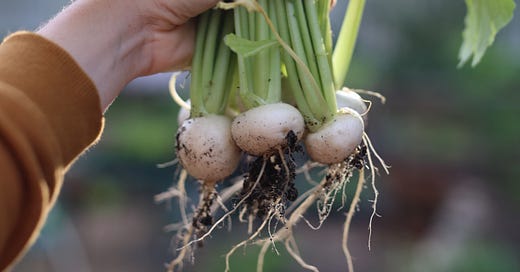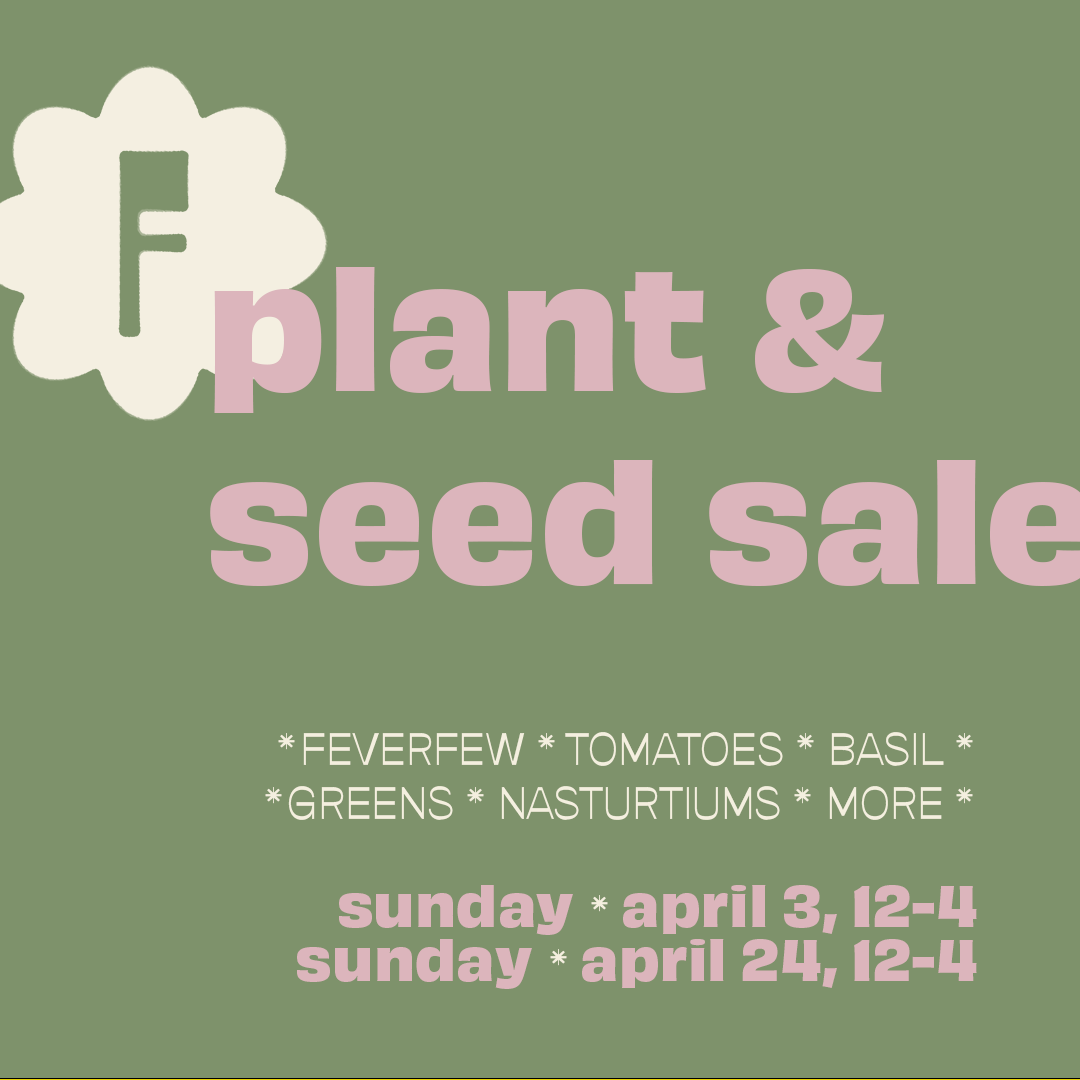
Since last weekend, I am pleased to report that all struggling babies have made a full recovery! Go babies go.
This week’s tasks have included….
fertilizing the roses
picking up leaf mulch and deep mulching several beds
building a soil screen to sift bark chunks out of my compost/potting mixes for seed starting - i used eric’s video but i used a staple gun instead of poultry nails
designing a full-property perennial garden, which includes 2 full sun ☀️ beds, a shaded pathway, and a collection of small shade areas 🌥
learning how to weigh and package produce to sell (packaging is extremely expensive right now, to the surprise of absolutely no one)
starting my next wave of lettuces indoors
getting my garden design business registered with local nurseries 🥳
prepping for this sunday’s plant + seed sale
scheduling my next virtual soil 101 class [it’s free! you’re invited!]
harvesting tokinashi turnips, baby kale, pink celery leaves, and purple radish microgreens for jordan, chef/owner of native root, for her pop-up at public house
taking several epsom salt baths to help my mysterious knee pain [knees are proof that god DOES in fact make mistakes, am i right??]
spring cleaning the garage
taking a macro economics course on masterclass
baking a lot: coffee cake muffins, chocolate chip cookies, almond pecan cookies, and this hummingbird cake for easter:
Trick for Planting Seeds / Vermiculite
Last week during office hours, we chatted about using vermiculite when planting seeds. Seeds and their initial roots are quite tiny, so you want to avoid compressing dirt by pushing a hole down for the seed - or putting large particles of soil on top (like those bark pieces that come in a potting/seed starting mix).
I love to place my seed on the top of the soil and cover with vermiculite. Vermiculite holds and keeps moisture, which helps the seed not dry out — and it also makes it really easy for me to see where I’ve planted.
Vermiculite is a naturally occurring mica that’s been heated to ‘pop’ or expand; it’s kind of like dirt popcorn. 🍿
It’s worth having on hand as a gardener, so pick up a bag of medium-grade vermiculite next time you’re at a nursery or supply store. You can mix it into clay soil to loosen it, and mix it with compost to create your own potting mix.
Medium is best for topping seeds, and Medium or Course can be used to amend soil. I’ve used a Fine grade in the past (which is almost like dust) and it was….fine… but I prefer Medium.
OKAY What On Earth Is Up With The Mints?
Full disclosure, I am writing this in order to learn it. Or rather, to remember it - because I re-learn it every year and it just isn’t sticking.
Like all plants, there are many types (18-25 varieties), with varying levels of flavors, scents, and uses. I currently have candy mint, chocolate mint, and lemon mint in my backyard — I think.
There are so many hybrid varieties popping up, and even different visual appearances in different regions, that trying to identify them is actually sometimes challenging. If you struggle to identify your own mint, it’s okay. There are flavor differences between them, but like all seasoning, you should go by taste rather than recipes - and all the mints below are pretty interchangeable.
As always, if you have any mint tips, corrections, or interesting things to add, please do so in the comments!
Note: Always grow mint in pots unless you have a very large area for it to take over. It’s root systems are invasive and you don’t want it to kill/suffocate everything else. Mint is an amazing plant for new growers, kids, or container/small space growers!

Spearmint // Mentha Spicata
This is what most people refer to as “mint.” It has the thickest, roughest leaf. You can identify it with the sharp “spears” on the leaf margin! It sometimes has more of a sheen to it than peppermint. I actually prefer this to peppermint because I like the texture and heft. While peppermint contains high menthol content, spearmint actually has low levels — it’s minty scent comes from a compound called R-(−)-Carvone. Carvone is fascinating; it’s approved for use as mosquito repellent and has medical-grade antibacterial, antifungal, and cancer-fighting properties.
Spearmint is the go-to for cooking and eating. As a really young child, I used to pick a handful of leaves, lay them out on a plate, sprinkle them with sugar, and put them in the freezer for 5 minutes before snacking on them.

Peppermint // Mentha Piperita
Peppermint has a thinner, softer leaf than spearmint. The tip is less pointed and more lobed, and sometimes has a bit darker green tone than spearmint (if it’s healthy). Peppermint is actually a cross between spearmint and water mint - so if you feel like they’re similar, it’s because they are. This variety has the highest percentage of menthol, and while also a great cooking mint, is traditionally considered the more medicinal type.

Chocolate Mint // Mentha Piperita
A cultivar of peppermint, this mint has smaller, rounder leaves with darker stems and leaf undersides. The leaf is thin (almost translucent sometimes) and pungent, and my day of research has led me to several chefs raving about its use in ice cream, sorbet, and cocktails. It seems to be the most fragrant of all the mints; when mint enthusiasts share their favorite, this is often The One.
Candy Mint // Mentha Piperita
Another type of peppermint, this one is being propagated/sold by many nurseries as a slightly sweeter peppermint, or an improved alternative to spearmint. I am 80% certain this is what I have, and I would prefer spearmint. :)
Orange, Lemon and Grapefruit Mint // Mentha Piperita ‘Citrata’
These all look similar to Chocolate Mint in appearance and have a subtle sweet, citrusy undertone in flavor. This entire group is recommended for fruit salads, fruit compotes; complimentary of any cocktail or dish featuring a fruit element.
Apple Mint and Pineapple Mint // Mentha suaveolens
Apple mints have much larger leaves that are often fuzzy; usually larger than pictured above. They’re sometimes called ‘wooly mint’ and very little is written about their particular use cases or strengths. Most people prefer this one for making jellies — but I plan to grow it and experiment myself. Pineapple mints have a white outline to the leaves.
Cooking With Mint
In the West, we often relegate mint to the dessert category. This is unfortunate, as mint adds so much life to savory dishes across the world, especially in Southeastern Asia, the Mediterranean, and the Middle East.
Mint is unusual in its flexibility and can be added to almost any type of dish to immediately freshen an everyday meal. Add it to a hearty salad (or a salad dressing), put finely chopped chocolate mint on top of a steak, make pesto with mint instead of basil [or half mint/half basil], or add it to a soup you love. Mix it into yogurt and toss with your favorite fruit, or put a handful into water and chill it overnight for a cooling mint water. Also, using mint to create summer pastas is a DELIGHT.
While you’re learning, just search for “[planned meal] and mint recipes” to see how others make it, and avoid any flavor combination mishaps.
*Mint is so good for you that even Harvard publishes mint recipes: Mint Vinaigrette.
➡️ UPCOMING CLASSES + EVENTS ➡️
Next Saturday I’m teaching a free/donation-based virtual class on creating good soil. 👩🏻💻 This is 50% intro to soil science, 20% how to identify different types of soil, and 30% how to compost or purchase the right stuff. You can RSVP here!
If you’re in Winston-Salem, come hang out at our retail shop @fancygroceries between 12-4pm on Sunday! I’m selling a heirloom tomatoes, basil, salad/kale mixes, nasturtiums, zinnias, yarrow, feverfew, and more — but more importantly, there’s ramen, local produce, and good music.
Weekly, 45 minute video hangout sessions with me + friends, to problem solve + collaborate on garden planning! 🌸 Come join us — it’s so fun. :) Every Thursday at 12pm + 6pm EST.
☀️ ☀️ ☀️
Cancel something you don’t want to do this weekend —
lauren xo
survival is a shrine, not the small space near the limit of life - diedrick brackens











